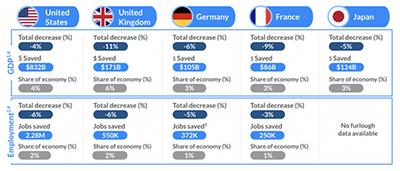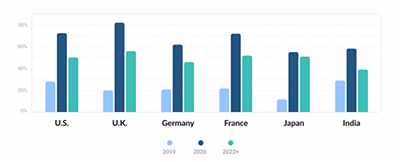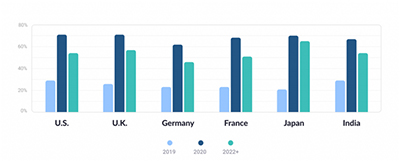The Impact Of Video Communications During COVID-19
Zoom commissioned an economic analysis and survey conducted by Boston Consulting Group evaluating the economic impact of remote work and video communications solutions during the pandemic.
As both a global health crisis and a resulting economic recession, the COVID-19 pandemic forced us all to find new ways to function in order to keep the public safe. Many turned to collaboration technology for continuity — video communications were suddenly our lifeline to society, enabling us to continue work and school in a digital environment. Any baby steps toward digital transformation suddenly had to become leaps and bounds, with people reimagining their entire day-to-day practically overnight.
To evaluate the economic impact of remote work and video communications solutions during the pandemic, Zoom commissioned the Boston Consulting Group (BCG) to conduct a survey and economic analysis, focusing on what industries were able to pivot their business processes using video conferencing, resulting in business continuity and even growth during a time of significant economic turmoil. The resulting report, prepared by Zoom based on the survey data and findings made by BCG, spans key industries and six countries around the globe, specifically looking at five U.S. states as well.
A few top takeaways from the report:
2.5-3.0x increase in employees working remote at businesses surveyed, which was supported by a 2.4-2.7x increase in employees using video conferencing solutions
The total time spent on video conferencing solutions increased 3-5x at businesses surveyed
BCG’s COVID-19 employee sentiment survey from 2020 showed that 70% of managers surveyed are more open to flexible remote working models than they were before the pandemic
Hybrid working models are here to stay — businesses surveyed expect over a third of employees to work remotely beyond the pandemic
Let’s take a look at some of the other findings.
Impact by country
As countries around the world grappled with lockdowns, people rapidly adopted remote work and video conferencing solutions. Through the swift and effective implementation of remote work, businesses within these countries were able to save both money and jobs that may have been lost as a result of the pandemic. In the U.S., for example, the ability to work remotely helped save 2.28 million jobs.
GDP and Jobs Saved by the Ability to Work Remotely

2020 vs. Q4 2019 2. Q3 2020 vs. Q4 2019 except USA (Q4 2020); accounts for furlough 3. Excludes government, entertainment, real-estate sectors due to lack of available data 4. India excluded due to inaccurate available GDP and employment sources
Source: Oxford Economics, US BEA, US BLS, UK ONS, Federal Statistical Office of Germany, France National Institute of Statistics
To look at how video communication solutions affect the way people work, both now and in the future, the survey aspect of the report asked respondents to estimate what share of employees in their company used video conferencing solutions in 2019, 2020, and expected to in 2022. Results were grouped by enterprise and small-to-medium-sized businesses (SMB). As we can see, companies expect video conferencing usage to stay significantly elevated post-pandemic compared to 2019.
Video Conferencing Usage for Surveyed SMBs (as % of employees)

Source: BCG B2B video conferencing customer survey, commissioned by Zoom
Video Conferencing Usage for Surveyed Enterprises (as % of employees)

Source: BCG B2B video conferencing customer survey, commissioned by Zoom
Impact by U.S. state
For this report, Zoom commissioned BCG to look at five specific U.S. states to examine the role of remote work and video conferencing in supporting small-to-medium-sized businesses during this time. The findings show us that video conferencing helped enable business continuity, introduce new ways of working, and even helped improve employee morale at the SMBs surveyed.
Here are a few of the insights:
- California: 88% of SMBs surveyed agree “Employees at my company rapidly adopted video conferencing solutions with limited training.”
- Florida: 61% of SMBs surveyed consider “Video conferencing solutions a must-have or very important for remote work.”
- Illinois: 75% of SMBs surveyed agree “Video conferencing solutions helped improve the productivity of my company’s employees during the pandemic.”
- New York: 72% of SMBs surveyed agree “Video conferencing solutions helped boost morale and mental well-being of employees at my company during the pandemic.”
- Texas: 13% average increase in revenue of SMBs surveyed, 2019-2020
Impact by industry
No industry was immune from the economic impact of the pandemic, but some were able to make dramatic shifts in behavior to adjust. For this survey, BCG took a look at how the healthcare, education, technology, and professional services sectors embraced remote collaboration to enable continuity during the pandemic and how the trends may continue in the future.
Here are a few of the insights:
- Healthcare: 67% of businesses surveyed agree “My company is considering a flexible remote working model because of successful remote collaboration through video conferencing solutions.”
- Education: 3.5x increase in the use of video conferencing solutions during the pandemic at businesses surveyed
- Technology: 84% of businesses surveyed agree “Video conferencing solutions will continue to be essential for business operations beyond the pandemic.”
- Professional services: 2.7x increase in remote work during the pandemic at businesses surveyed
The future of work
The COVID-19 pandemic made remote work a necessity, but the trend is here to stay. Some workers will go back into the office after the pandemic, but most others will still collaborate virtually as remote or hybrid employees.
In fact, the Boston Consulting Group research findings reveal that remote work will remain prevalent in almost all the countries surveyed.

Source: BCG B2B video conferencing customer survey, commissioned by Zoom
Building forward, together
COVID-19’s impact has been profound. The world is different and the workforce is everywhere. The report’s findings tell us that people will continue to work together to overcome any obstacles ahead and technology will only continue to play a pivotal role in defining what’s next.
To learn more about the economic impact of video conferencing and remote work during the pandemic and what’s next for today’s businesses, read the entire “The Impact of Video Communications During COVID-19” report.
And to discover how you can empower an agile, hybrid workforce, check out our Building Forward resources.





